Review and photos by Bokisaurus, edited by Plesiosauria
The Eocene had some really strange looking animal. The Eocene Epoch was the time when many of the famous large mammals started to diversify. A lot of the hoofed animals we are familiar with today first appeared around this time. One of the strangest of these new groups of large mammals were the Dinocerata (‘terrible horned’). This group of large plant-eating animals had a body plan very much like rhinos. As a group, they are famous for their paired horns and saber-like canine teeth. Yes, very odd indeed. Imagine combining a rhino with a giraffe, then add in a dash of saber-tooth cat – you get one truly bizarre looking beast.
The most famous of the group is Uintatherium ( “Beast of the Uinta Mountains”), the subject of our review today. CollectA finally released their take on this unique animal this year. Although there are some figures of this species represented in the toy world, this is the first time that we get a large, beautifully sculpted figure.
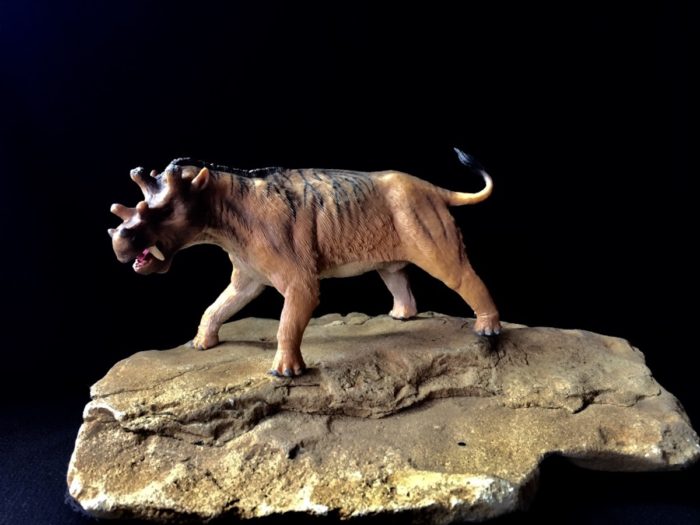
Uintatherium is a large animal, estimated at being 13 feet long and around 5.6 feet high with a weight of around 2 tons. Looking at it, one could easily assume that it is related to rhinos due to their similarity in body shape ( at least as commonly depicted in popular art). But the two are not related. In fact, how and where exactly the group Dinocerata relates to other mammals is still up for debate, although the most commonly accepted relationship is that they belong to the ungulate group. So, let’s take a look at this new figure from CollectA by first looking at the head, and it’s most unusual and unique features. The most intriguing and unusual feature of Unintatherium is its paired horns and dagger-like canines. The three pairs of horns all projects upwards with the first pair situated on the tip of the snout, the second pair just before the eyes, and the final and largest pair situated on the back of the skull just above the ears.
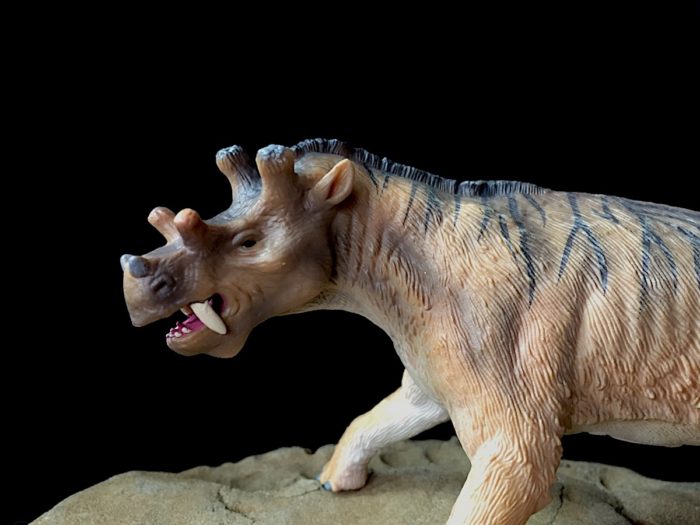
The figure faithfully recreates these paired horns and they are beautifully sculpted. The large, saber-like upper canine is also beautifully sculpted as well. This feature is believed to be larger in males than in females (sexually dimorphic). The other teeth are small and individually sculpted. I am impressed by how crisp these teeth are considering how small they are, they are very well defined and you can feel the individual teeth. The mouth is slightly open, so you can interpret it either as an aggressive display or simply just browsing. The eyes are small and sit high up on the head. The eyes are painted black, but the shiny gloss makes it look real and alive. The cheekbone is prominent, as well as the two protrusions just below the chin/lower jaw.
Despite its fearsome appearance, Uintatherium was not very smart. In fact, the shape of its skull is concave in shape; that is the skull dipped inwards instead of outwards (more typical of other animal skulls). This odd skull feature, combined with thick walls of the skull left little room for brains. So yeah, this animal is not a candidate for a spelling bee. This unique nice skull feature is faithfully recreated in this model. It is believed that Uintatherium exhibited sexual dimorphism. In males, the horns and the canines are larger and more prominent than seen in females. The exact purpose of these enlarged canines is not fully known, but some believe they are used for feeding in addition to display. There were not many predators large enough to take on a fully grown Uintatherium. Looking at the model’s head, there is no doubt that it is a male, and one quick look at its private parts will confirm it!
Moving on to the body, the neck is short and muscular in this figure. When one pictures what Uintatherium may have looked like, the image of an animal that looks like a hippo or rhino comes to mind. This is what we typically see in many artworks.
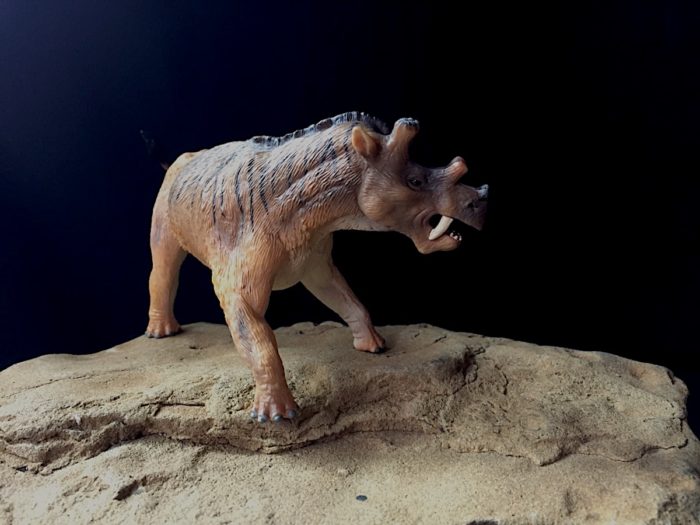
CollectA’s interpretation gives it a slightly different look than what we have come to expect. In this model, the animal still has the basic rhino/hippo built, but it has a short mane running down the back of the neck. This is a feature not commonly seen or associated with Uintatherium. The short mane is colored black. From the mane, dark stripes radiate downwards towards the shoulders. There is also a dark stripe that runs from the neck, down the spine, and all the way to the base of the tail.
The overall color of this figure is light brown, with the belly and inner thigh being lighter shade, almost tan in color. In addition to the mane, the body of the figure also show hairs. In fact, this interpretation of Uintatherium is unique in that it is one hairy beast! There are hairs all over the body, and towards the belly, tufts of curly hair can be seen adoring the sides as well as the back legs. The hair is well done, and not extreme that the animal looks like a wholly rhino. I personally like this look, it’s a very different and refreshing look than what we have come to expect. The additions of hair/fur, as well as the pose, give this figure a somewhat equine feel to it.
The pose is active. Both front and back legs are robust and equipped with claws. The front legs are splayed out, as if the animal is about to charge a rival or an enemy. The back legs are firmly planted on the ground and is straining as if the animal is pushing itself forward. The well sculpted muscles add to the tension. The tail is up in the air, you can almost picture it swishing back and forth. Last, but definitely not the least, if there is any doubt as to what sex this figure is, look no further than the private parts and you will see the “big” confirmation that it is without a doubt a male in his prime!
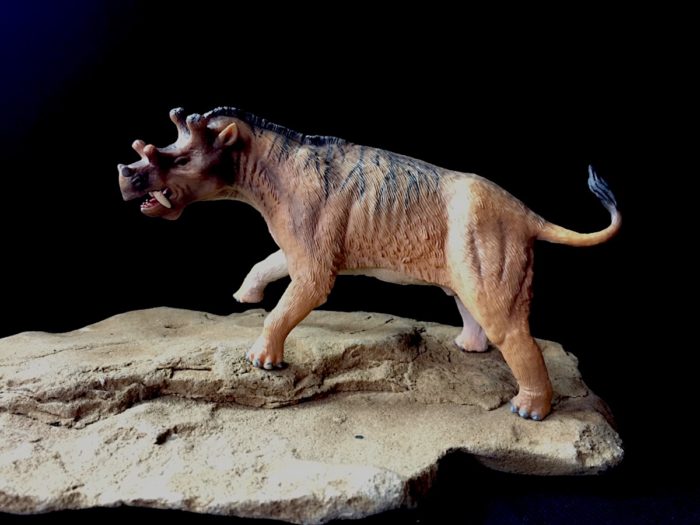
Uintatherium was one of the first megafauna mammals that was discovered in the early days. This bizarre creature also has the distinction of being involved in one of the most famous bone wars between Edward Cope, O.C. Marsh, and Joseph Leidy, as they tried to out-compete each other to name extinct animals fossils that they found. In the end, Leidy would eventually win and coined the name Uintatherium (after the Uinta Mountains) first. The first fossils were discovered at Fort Bridge in Wyoming. Fossils were also found in Utah near the Uinta Mountains. With both Cope and Marsh rushing to name new species, multiple names were given to the same animal. Today, there are two recognized species of Uintatherium. The American one, U. anceps (type) of the early to middle Eocene and the Asian one, U. insperatus of the middle to late Eocene that was found in China.
As a group, Uintatherium had a surprisingly long reign despite not being the smartest creature in the land. How the group survived for so long no one really knows. Perhaps their large size was enough to make them the unchallenged dominant herbivore during the early Eocene, with very little competition. But like all the other megafauna before and after them, the Uintatherium would one day go extinct. As the Eocene progressed, new cast of characters started to emerge. Soon, other large herbivores such as the bronthotheres and early rhinos started to diversify and dominate the landscape. Perhaps these newcomers started to outcompete the Uintatheriums, pushing them closer and closer to extinction. Climate change may also be a big factor in the extinctions of the Uintatherium. Maybe with the new and rapidly changing environment they simply could not adapt quickly enough despite being around for so long. No one really knows for sure what drove this magnificent beast to extinction. In the end, the curtain of extinction would fall, and the once mighty herds of Uintatherium vanished from the landscape leaving no descendants. Their disappearance would open the door for the brontotheres and rhinos to flourish and dominate the newly vacated landscapes.
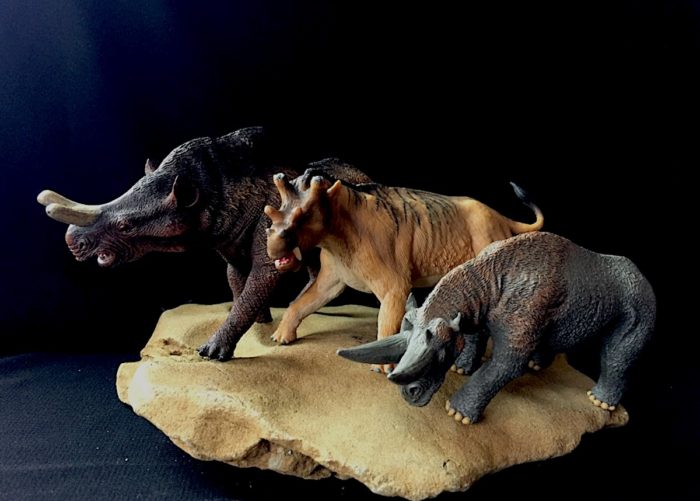
In closing, I really like this model. I was very excited when I heard that CollectA was releasing a figure of it as part of their new 2017 lineup. I was not disappointed when I finally got the figure. It is very well sculpted and researched. The slightly more hairy look is a nice welcome. The figure’s active pose is flexible enough to be interpreted in many ways. The color choice is not for everyone, but for me personally, I like it. It’s a nice break from the normal gray that one see in art. The color also goes well with the more hairy look of the figure. If you are a fan of prehistoric mammals, this is one figure that you should definitely add to your menagerie.
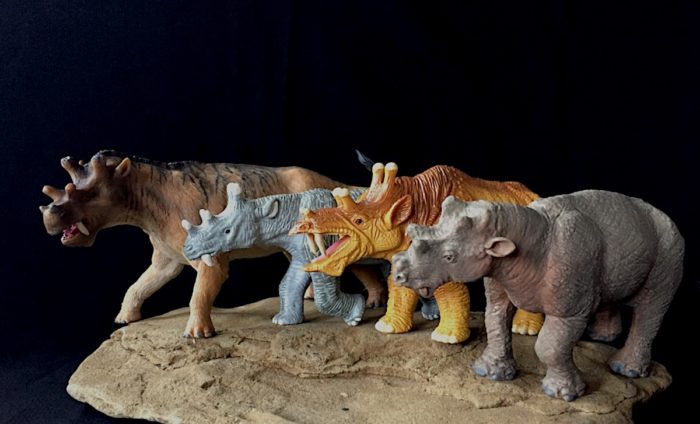
Hope you all enjoyed this review of one of the most fascinating and unique prehistoric mammal. Until the next review, Cheers!
Disclaimer: links to Ebay and Amazon on the DinoToyBlog are affiliate links, so we make a small commission if you use them. Thanks for supporting us!




Yes, it seems to be a consensus that this magnificent creature was probably not the sharpest knife in the drawer, so to speak. But, likely enough, it was about as smart as it had to be. Taking our modern rhinos as an example, poachers aside (a pox on them!), there seems to be a niche for not-so-bright, near-sighted and grumpy critters who are ready to charge at a moments notice. The stance given this specimen by CollectA appears to support this conjecture. A review well-done and thanks for the fine photo display, as usual.
I am always very impressed by CollectA. It makes us great surprises; interesting, obscure species, like its Gompotherium model among its other 2018 models. As a starter in dinosaur model collecting, I only collect dinosaur and prehistoric reptiles. But CollectA’s beautiful prehistoric mammal figures encourage me to collect also prehistoric mammals.
For this year, I only got the little but beautiful 2017 CollectA Regaliceratops. I also saw the Huge Deluxe Styracosaurus, but I did not get it. Instead, I got the CollectA Jobaria and a woolly mammoth baby.
I love both CollectA and Safari Ltd, but I have noticed that they both either make the same species each year or one after another one. But still, we get different points of views of the species by both companies, for example the 2 Uintatherium models made by both of them.
Very detailed,informative and enriching review and crisp photographs. I am seeing how I can submit at least one review also.
This is one of the finest megafauna figures CollectA has ever made. I especially like that it has visible fur as opposed to a standard rhino or hippo appearance. A must-have for sure!
Me too! I am very excited that we got an Uintatherium with fur and one without fur/ hairless by Safari Ltd.
Of the best that has been made of uintatherium and whose only figure that rivals in the toy market is that of Safari without that means that of other companies such as the legendary uintatherium Play visions (almost impossible to find in the toy market ) do not stop being another great figure.
I really like the interpretation of Collecta’s uintatherium made by Doug Watson and his team and for me it was a figure next to the estemmenosuchus and elasmotherium that I most wanted to have in my collections of prehistoric animals. On the other hand I congratulate for the review of the toy figure of that impressive animal that is very well documented and helps people who are profane in the field to know a little better the universe of animal paleontology.